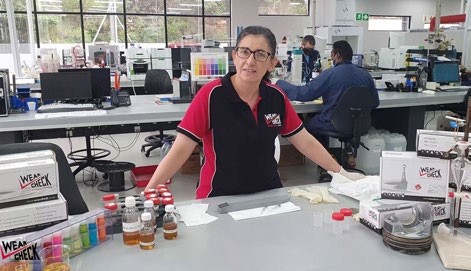ADDITIVES SELECTION
The lube kitchen – getting the right mix

WearCheck technical manager Steven Lumley highlights the importance of choosing the correct additives for lubricants to keep engines running smoothly.
SOURCE | WEARCHECK
T
he mining, manufacturing, power generation, construction, aviation, maritime, and automotive industries, as well as many other sectors, rely heavily on lubricants to keep components operating smoothly. Selecting the right additives helps boost machinery efficiency and reliability.
Condition monitoring specialist company WearCheck provides predictive maintenance services to a wide range of businesses operating in an extensive range of sectors, including those that operate fleets of trucks, mining vehicles, agricultural vehicles, ships, planes, transformers, and more.
WearCheck Technical Manager Steven Lumley elaborates: ‘Fully formulated lubricants have many functions and are classified into five fundamental groups: reducing friction/wear, dissipating heat from critical machine components, removing/suspending deposits, protecting metal surfaces from degradation/corrosion and acting as a structural material.
‘Lubricants serve a diverse range of applications - from car engines to water pumps to the bobbin cases of sewing machines - each requiring different combinations of base oils and additives.
‘Blending and formulating lubricants is complex, requiring a high degree of engineering and complex chemistry and an in-depth understanding of the ingredients’ chemical qualities and how those chemicals interact.
‘Base oils perform most of a lubricant’s functions but can only do part of the job. Additives are needed when a lubricant’s base oil doesn’t provide all the necessary properties. They improve the excellent properties of the base oils and minimize the bad. Typical lubricants contain a base oil, an additive package, and, optionally a viscosity index (VI) improver. Lubricant additives are organic or inorgan-ic compounds dissolved/suspended in oil.

Selecting the correct lubricant plays a key role in boosting engine efficiency. Condition monitoring specialist WearCheck outlines the pros and cons of various additive combinations.
SOURCE | WEARCHECK
‘Not all lubricants contain the same combination of additives and certainly not in the same treatment rates. Depending on the application, additive concentrations range between 0.1% to 30% of oil volume. Turbine, hydraulic, and industrial gear lubricants demand much lower treatment rates of additive packages than automotive gear, transmissions, petrol, and diesel engines, which are the most demanding and require the most additives.
‘Different lubricant additives have different functions. They are also chosen for their ability to mix easily with the selected base oils, to be compatible with other additives, and to be cost-effective.
‘The geometry and metallurgy of the components, operating temperatures, load, potential exposure to contaminants, combustion products, and typical drain intervals are all considered when selecting the ideal cocktail of additives.
‘The optimal base oil/additive combination allows the finished lubricant to meet specified properties and performance characteristics outlined by OEMs and lubricant standards organizations. ‘
Please visit www.wearcheck.co.za or email marketing@wearcheck.co.zafor more information..